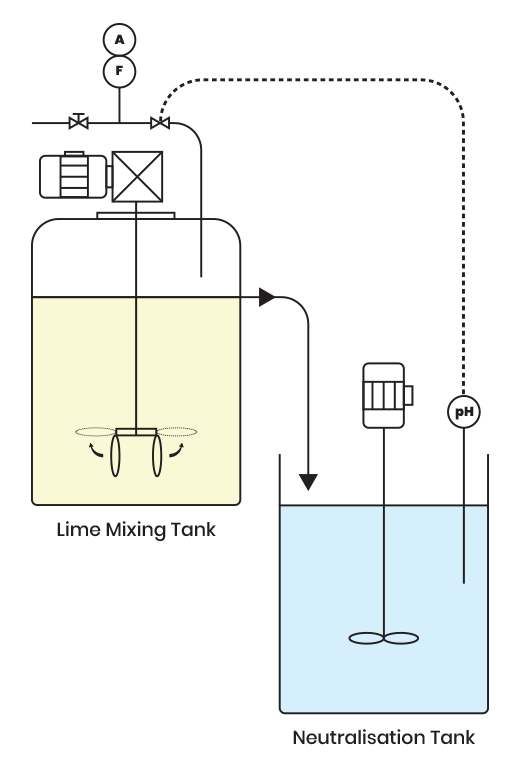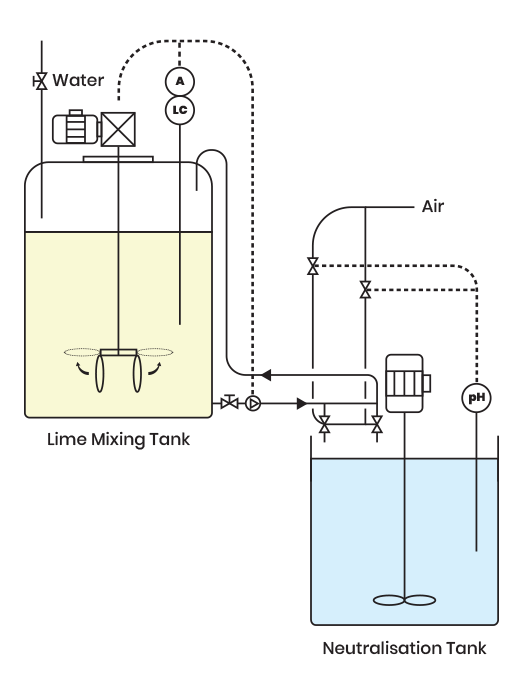Reliable Lime Dosing
What is Lime Dosing?
Going back 20 or 30 years ago lime dosing for pH adjustment was popular, as lime is a plentiful low cost reagent. The disadvantages of using lime are that it's messy, difficult to store, and with it being supplied in paper bags it needs to be kept dry. Mixing lime is also an unpleasant, time-consuming task and that's before the difficulty of dosing the mixed solution. We have supplied equipment to a good number of customers who have changed over from lime to caustic dosing for pH adjustment successfully. Although dosing caustic in low temperatures can have it's own problems.
Some waste water streams work best when dosed with lime such as when precipitating metals or solutions containing fluorides, as the sludge is usually denser than when dosed with caustic. However - remember for every kilo of lime dosed there will be approximately 1 kilo of sludge to dispose of.
Traditionally we have offered two different types of lime dosing systems for installation a simple low cost lime dosing system and a recirculating lime dosing system.


Simple Lime Dosing
The simple low cost lime dosing system is designed for low flow rates and comprises of a mixing tank with a geared mixer. Here the lime is mixed with makeup water. The makeup water is added to the tank via solenoid valve and water meter with a contacting head. The pH controller controls the solenoid valve with the pH electrode installed in the neutralising tank.
The lime-mixing tank overflows into the neutralising tank. The pH controller calls for lime dosing on a low pH, the water valve then opens introducing water into the mixing tank and causes the mixed lime solution to overflow into the neutralising tank. Adding water to the lime-mixing tank causes the milk of lime solution to become diluted. We supply a small panel with a counter and an alarm so that when a pre-set volume of water has flowed, the alarm is triggered alerting an operator to add more lime to the mixing tank, and the alarm and counter are then reset.
Recirculating Lime Dosing
Our second system is to again use a mixing tank with a geared mixer to keep the lime solution in suspension. The tank is connected to a recirculation pump that pumps the milk of lime around a ring main. The ring main can be fitted with duty and assist valves to dose the lime into the neutralising tank, which is controlled by a pH control loop. The mixing tank will require level controls to stop the mixer on a low level and to alarm, alerting the operator to make up the lime mixture.
The best systems are fitted with a water wash system to flush out the ring main after use, and this process can be automated. Larger systems could have automatic make up from lime silos, but these fall outside of our scope of supply as an instrumentation and dosing supplier. A more modern approach to the problem of dosing lime is to use one of the prepared lime solutions supplied by several suppliers under their own trade names and supplied ready in mixed in an IBC.
The challenge is how to accurately dose this product from the IBC. The first issue is that the lime to needs to be mixed inside the IBC to keep it in suspension. So an IBC mixer is required - this is a geared mixer with a clamp on bridge to suit the IBC. The mixer blades hand down like bananas and expand outwards when running so they will fit through the 150mm Ø port on top of the IBC. The dosing of the lime can be carried out with a peristaltic pump controlled by either a PWM relay or better still, from an inverter. Both are available from P7687 or P6587 pH controllers, which will work with an antimony electrode if the wastewater contains Hydrofluoric Acid. We are able to supply equipment for any of these systems above, with the option of a ready-wired panel for easy site installation.

Contact us today to enquire about Reliable lime dosing, we are here to help.

